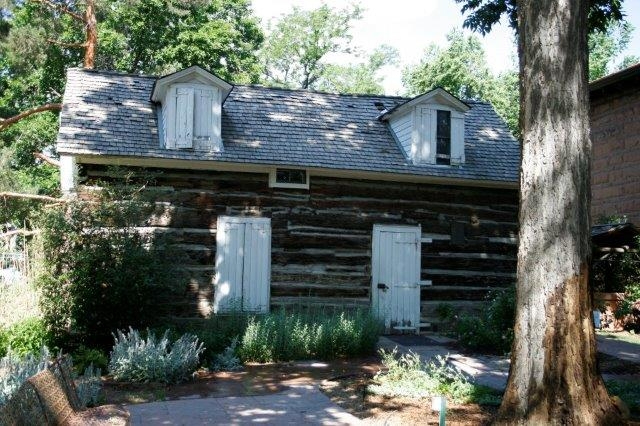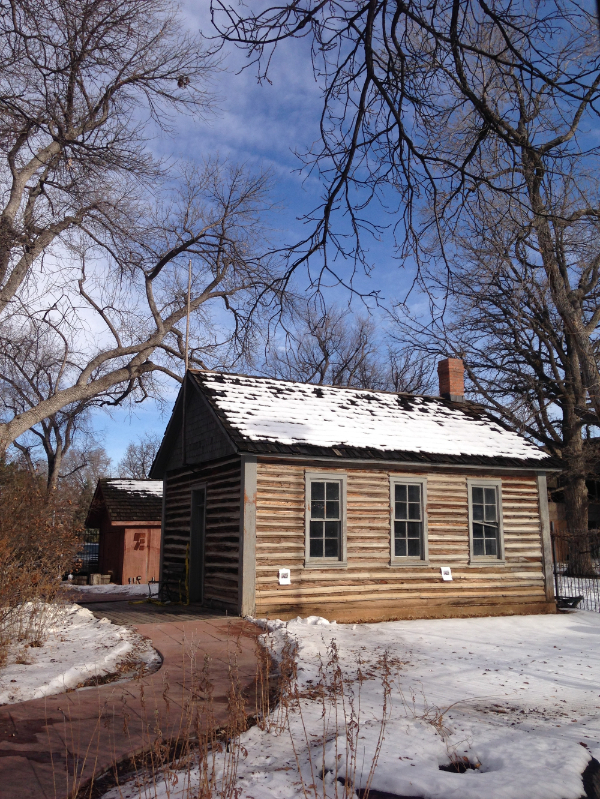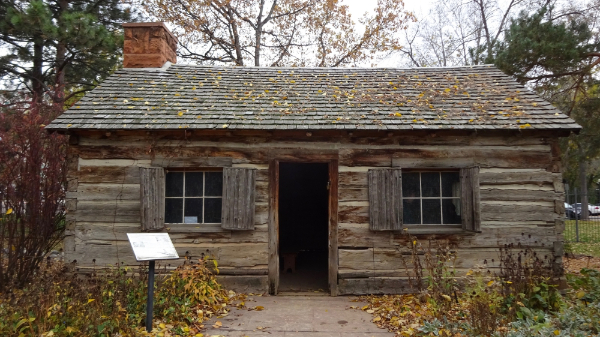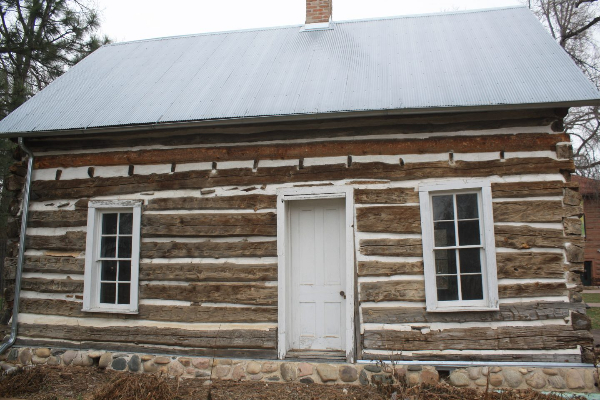HISTORIC HERITAGE COURTYARD#
Situated on the grounds of the historic Carnegie building, and adjacent to the site of the former Pioneer Museum, the Heritage Courtyard at the Center for Creativity [CC] house some of the area's oldest European buildings. Moved over the last century from various other parts of Fort Collins and Larimer County, today the Heritage Courtyard is home to four wooden structures, each with their own distinctive history in the settlement story of the region.
Preserved by the Fort Collins Museum of Discovery and managed through a partnership with the City of Fort Collins - Cultural Services department. The Heritage Courtyard at CC today is a place to explore the areas history up close, while also providing a unique setting for outdoor special events.
Discover more about these historic structures below!
Auntie Stone Cabin#

The "Auntie" Elizabeth Stone Cabin Elizabeth Stone is one of the most beloved figures in our community's history. A celebrated cook and hostess, she was the social center of early Fort Collins life. From this log house, built in 1864 near present-day Linden and Jefferson Streets, she and her husband Lewis ran the dining hall at Camp Collins during its years as a military post. The soldiers affectionately nicknamed her "Auntie" for the comfort she brought to their lives far from home.
Elizabeth Stone later partnered with Henry Clay Peterson to start the city's first flour mill and brick kiln. An ardent supporter of women's suffrage, Stone voted for the first time in a municipal election in 1894 at age 93. When she died one year later, all local businesses closed for her funeral while the bell in the firehouse tower tolled 94 times, honoring each year of her long, active life.
After the Camp was closed in 1867, this building served a variety of purposes and was moved several times. The cabin's last major journey occurred in 1959, when it was relocated from 215 Mason Street to its present home here at the Heritage Courtyard. It is the only building
that remains from Fort Collins' years as a military post.
"Arrived at Collins last night, found Aunty Stone well, she has a very comfortable home for this country... my private room has an ingrain carpet, nice bed, window, with a nice sunset view, with hills and the pretty Cache-a-la-Poudre."
-1866 diary entry of Elizabeth Keays, niece of "Auntie" Stone
Upper Box Elder Schoolhouse#

Imagine going to school in this one-room schoolhouse, with other farmers' and ranchers' children of all ages, from miles around. A pot-bellied stove would keep you warm on chilly days, and along with learning reading, arithmetic, and penmanship you'd help with daily chores such as raising and lowering the flag.
The schoolhouse was built in 1905 and originally was located 35 miles north of Fort Collins on the Maxwell Ranch, about five miles east of Highway 287. It was in regular use until 1950 when the school was closed. After 1950 the schoolhouse stood abandoned until it was donated to the Colorado State University Research Foundation in 1975. Slated for demolition, it was saved by the Victorian Questers organization and moved here to the Heritage Courtyard in 1976.
"We were pretty close. Everyone, children and adults, participated in school activities... we were like a big family!"
-Ella Nauta, teacher at Upper Boxelder School from 1938-1940
Joseph Antoine Janis Cabin#

The beauty of this area has captured the hearts of many, including a French-American trader named Joseph Antoine Janis. Originally from St. Charles, Missouri, Janis first struck a land claim about seven miles northwest of Fort Collins in 1844, near present-day Laporte. Returning to the area in 1859, he built this cabin from Ponderosa pine.
Others joined Janis there to found Colona, the first town site platted in what would become Larimer County. Janis married First Elk Woman, a member of the Oglala Lakota tribe, and together they raised a large family. But in 1878, when the U.S. government forced the Lakota people to relocate to a reservation, Janis faced a difficult choice-stay in his home or leave with his family. Janis chose his family, and together they moved to what is now the Pine Ridge Reservation in South Dakota.
The Janis cabin was moved in 1939 to its home here in the Heritage Courtyard. The preservation of this weathered log structure sparked the creation of the Pioneer Museum, predecessor to today's Fort Collins Museum of Discovery.
"...I thought the Poudre valley was the loveliest spot on earth, and I think so yet"
-Antoine Janis, 1883
Franz-Smith Cabin#

Fort Collins' rich agricultural history spans the late 19th century, through the Depression, and into the modern era of rural electrification.
This is the house that German immigrants and homesteaders Henry and Caroline Franz built in 1882, near present-day Shields Street and Harmony Road. Here they raised their children and farmed sugar beets and lambs - two agricultural commodities that shaped Fort Collins' early growth and identity.
In 1936, the house and 160-acre Franz farm was bought by the Smith family, who raised sheep and cattle. The Smiths wired the house for electricity, but never had running water! The Smiths lived in another house on the property, but continued to use this structure for extra space until they sold the property in 1987.
Are you interested in renting the Heritage Courtyard for a special event or wedding?